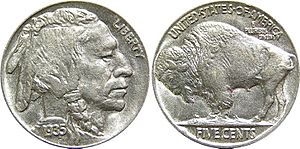Natural Bridge Park facts for kids
Natural Bridge Park is a special place in Winston County, Alabama. It's near the town of Natural Bridge, Alabama. This park has been open since 1954. Jim and Barbara Denton are the current owners.
The park offers many fun things to do. You can have a picnic or drink fresh water from an artesian well. There's also a gift shop with unique handmade items. You can also explore a 30-minute nature trail. Along the trail, you might see 27 different kinds of ferns. You can also spot a type of hemlock tree that has been around since the Ice Age.
The Natural Bridge
The main attraction at the park is the amazing Natural Bridge. This huge rock formation is 60 feet (18.3 meters) high. It stretches 148 feet (45 meters) long. The bridge is made of sandstone and iron ore.
This Natural Bridge is very special. It is the longest natural bridge found east of the Rocky Mountains. You can find it right here in North America.
The Indian Head Rock
Downhill from the Natural Bridge, there is a unique rock formation. It looks like a large American Indian head. You can see its profile, or side view. It looks a lot like the image on an old American Indian Head nickel.
This stone image is quite big. It stands just over 15 feet (4.6 meters) tall. It's a fascinating sight to see in the park.
Visiting the Park
As of 2015, the cost to enter the park was $3.50 for adults. For safety reasons, visitors are not allowed to walk over the bridge. Instead, you can walk underneath it to see its impressive size.
The park is open every day of the week. You can visit from 8:00 A.M. until sunset.
History of the Bridge
The Natural Bridge formation is incredibly old. It began to form about 200 million years ago. Over millions of years, water slowly wore away the softer sandstone. This left behind the stronger parts of the rock, creating the natural bridge shape.
The park itself opened to the public in 1954. Long ago, the Creek Indians lived in this area. They likely used the space under the bridge for shelter. The origin of the Indian stone head formation is not known. This location was once called "Lodi."


